A towering witness to Spain’s rich history, for over eight centuries, the Mezquita-Cathedral of Cordoba is an architectural highlight like no other! The complex structure, steeped in an even more complex past, showcases the intricate artistry of the Moorish era, featuring Islamic patterns and adornments, that sit snugly with the Christian cathedral built at the site in the 16th century. Here are the must-know details about Cordoba Mosque that will enhance your visit to this renowned UNESCO World Heritage Site.
Essential information for visiting Cordoba Mosque
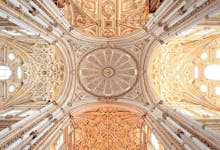
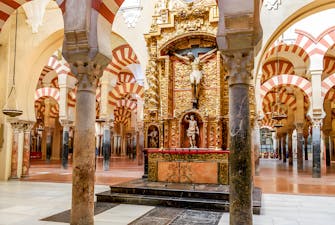
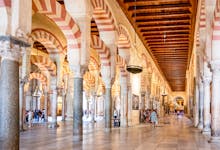
Good to know
| ☀️ Best time to visit : | During Spring (March-May) |
| ⏰ Suggested Duration: | Approximately 2 hours |
| 🎟️ Mezquita Cordoba Tickets: | €17 |
| 🚌 Closest bus station | Puerta Del Puente |
Opening Hours
10am–7pm (depending on the season)
Things to know
Number of visitors per year: 1.5 million approximately
UNESCO World Heritage Site designation: 1984
Opened to the Public: 987 A.D.
Architectural style: Moorish with notable influences from Islamic, Christian and Renaissance architectural styles.
Highlights
The Hypostyle Hall
The Mihrab
The Courtyard
The Dome
Address
Calle Cardenal Herrero,
1, 14003 Córdoba, Spain
Get There
Why you must visit Spain’s Cordoba Mosque
One of Andalusia’s most celebrated landmarks, the Cordoba Mosque is a must-visit because of its unique history and architecture. After all, there are few places in the world where you’ll see a centuries-old mosque stunningly interwoven with a historic church. A tour of the Mezquita-Cathedral of Cordoba, commonly called the Cordoba Mosque, will immerse you into the region’s Moorish past and the Christian reconquest that unfolded centuries later. The site is also unmissable for its remarkable architectural elements, highlighting Islamic, Christian and Renaissance styles.
Know before you book your tickets to the Cordoba Mosque
- There are separate tickets to the Mezquita-Cathedral of Cordoba and the Bell Tower. Ensure you have tickets for each experience if you want to leave nothing out.
- Opening hours differ daily and may even be reduced if there are any special events. We recommend you look closely at the day's timings on the official website to avoid confusion and disappointment.
- This is a functioning, Catholic, religious site. Visitors are expected to maintain decorum and also dress modestly.
- While advance booking is not insisted upon, we recommend you book your tickets early especially if you are travelling during peak season when the lines are long and waiting outside in the heat can get to you.
- Tour guides are often accompanied by subject-matter experts so if you want to know every tiny and big detail, that’s worth knowing about Cordoba Mosque, we recommend you sign up for a guided tour.
Recommended tickets
Cordoba Mosque history
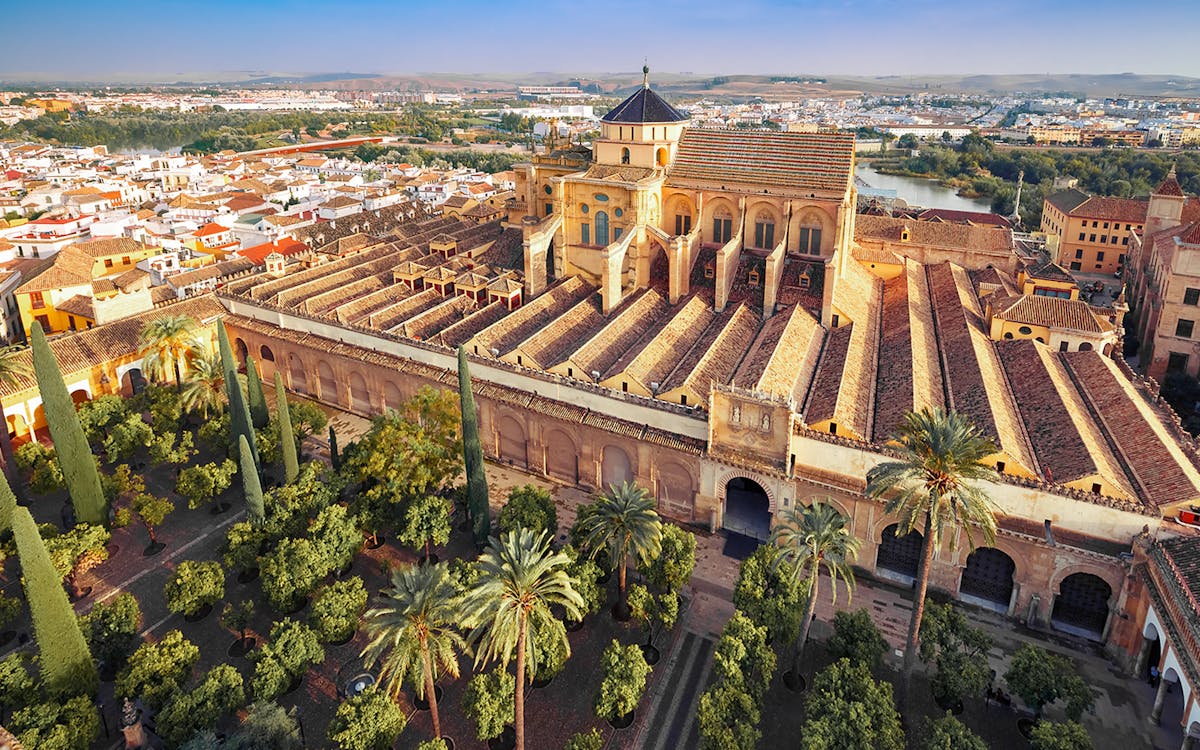
Ancient lore traces the origins of the Cordoba Mosque site to the Romans, claiming that there once stood a temple dedicated to Janus on the holy ground. This, then, apparently gave way to a Visgothic Church that also shared its premises with a mosque.
While these origin stories have often been challenged, the initial iterations of the majestic mosque that stands in Cordoba are definitively credited to Abd ar-Rahman I, who founded the Umayyad Emirate in 756 AD. Even in those ancient times, the mosque only took a year to complete (it is estimated that construction wrapped up between 786 and 787 AD) since it interwove existing structures into its design and construction.
In these early days, the mosque is said to have consisted of courtyards, naves, and two-tiered arches – that gave the monument a framework. However, successive rulers then embellished and added stunning flourishes to the complex, transforming the Mosque into a visual treat and showcasing intricate work that spotlighted Moorish architecture.
Once the Spanish Reconquest took place in the 1200s, Catholic rulers began to add the elements of Christianity into the structure with small chapels and altars coming up. However, the first major alteration came up in the 14th century with the addition of the Royal Chapel – which paid ode to the locally perfected Mudejar style.
Finally, in 1523, a grand Renaissance Cathedral sprouted in the middle of the Islamic structure. A nearby minaret was also replaced by the Bell Tower that stands in the complex.
Since the 19th century, efforts have been made to recover parts of the lost Mosque. And, today, the Mezquita Cathedral is an outstanding example of Andalusia’s textured history and its journey through the ages.
Cordoba Mosque’s unique architecture
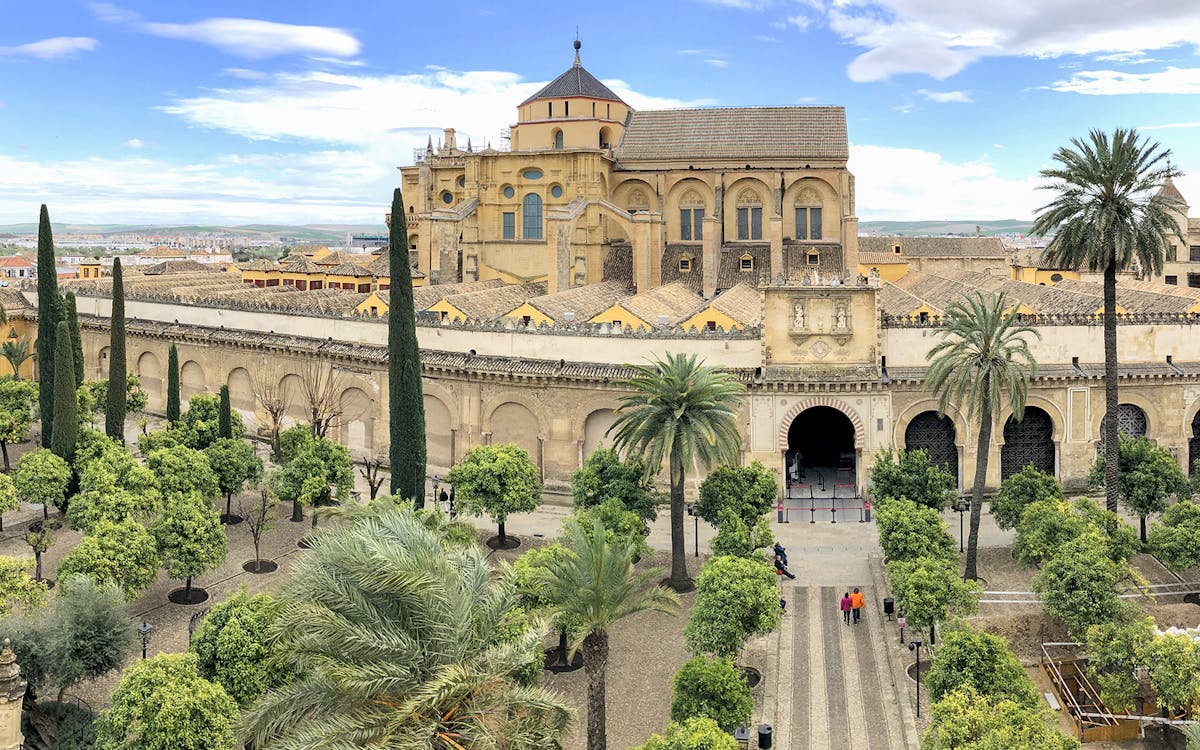
At the height of its glory, the Grand Mosque of Cordoba was one of the most celebrated places of worship in all of the Islamic world. Andalusia’s Moorish rulers lavished special attention on the monument, creating elegant structural extensions that were, then, heavily embellished with geometric designs, dazzling gold flourishes, and deep pigments. Sitting amidst thick, fortress-like walls, the Mosque is made up of galleries, courtyards, and elevated passages. Amidst this, centuries later, the Cathedral has broken through the Islamic structure’s prayer hall. While the newer, Christian additions to the complex carry on the flourishes of the Moorish-era architecture, they also showcase Gothic and Renaissance elements that truly make the Mezquita-Cathedral an unforgettable architectural wonder.
Your Cordoba Mosque tour deconstructed
1The hypostyle hall
Possibly the most pictured site at the Mezquita-Cathedral, the hypostyle hall is a lesson in pleasing symmetry. Built to serve as the Mosque’s main prayer hall, the large space is marked by rows of columns that are topped by two-tiered arches. Many of the columns are said to be standing through the Roman era and as the hall expanded through the centuries, so did the columns. Today, the hall is populated with 850-odd columns standing in a neat, order – one behind the other. They are topped by two-tiered arches that feature decorative wedges that are alternately painted in white and deep red. Also remarkable are the wooden ceilings covered in intricate, golden patterns that add sheen to the structure.
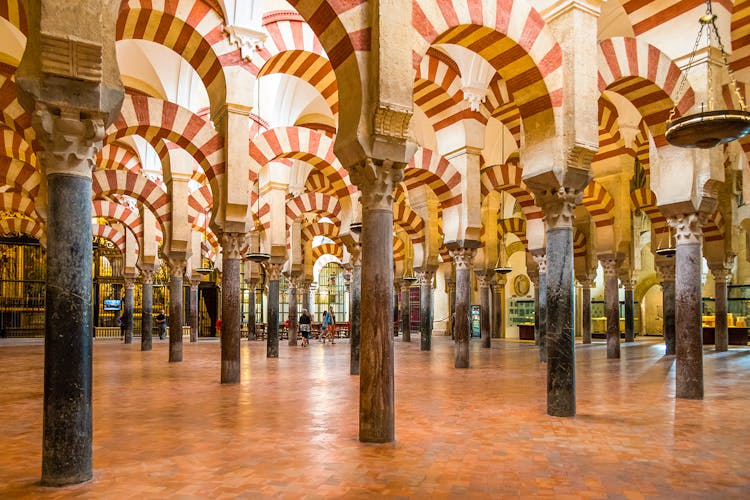
2Villaviciosa Chapel dome
Moving past the columns of the hypostyle hall, your eyes are sure to be transfixed by the splendour of the Villaviciosa Chapel dome. Added to the Mezquita during the 10th-century renovations taken up by Al-Hakam, the ruler of the time, the dome is fronted by a series of interlaced, decorated arches that speak of the richness of the architecture. The ribbed dome itself is fitted with intersections that create an elegant rhombus-like structure. Inside these overlapping arches, flowers and other geometric patterns bloom.
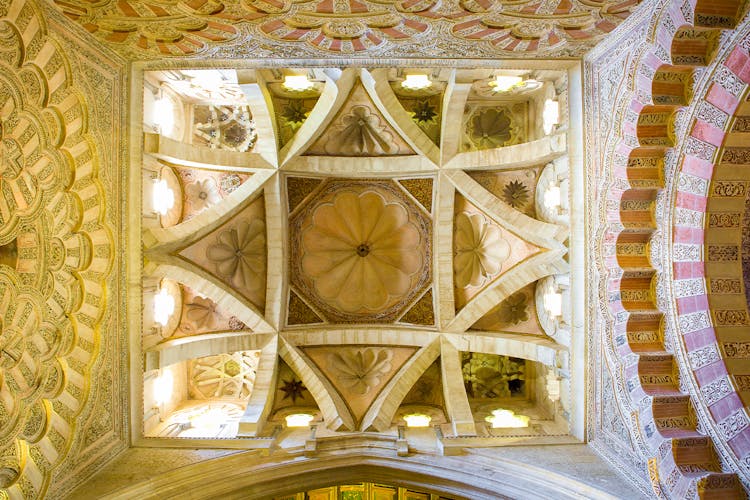
3The Mihrab and Maqsura
The glittering heart of the Cordoba Mosque is made up of the twin splendours of the Mihrab and Maqsura. Located to the south end of the prayer hall, the Mihrab, in Islam, indicates the direction of Mecca, the direction in which prayers are offered. At the Cordoba Mosque, the Mihrab is a large, horse-shoe niche in the wall lavishly decorated with gold, floral, motif work and inscriptions from the Quran. This is surrounded by the intersecting arches of the Maqsura – the dedicated space of worship of the Emir or the Caliph – that are topped by skylit domes.
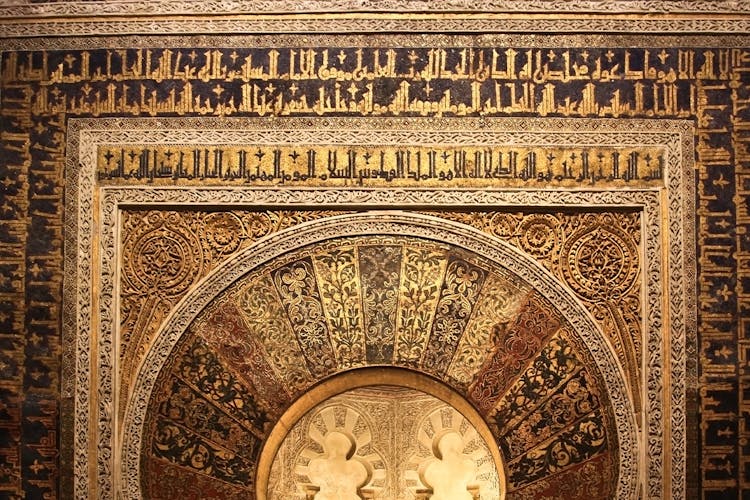
4Capilla Mayor or the Cathedral
While the Cordoba Mosque complex is dotted with numerous chapels, Capilla Mayor requires your utmost attention. Built and decorated over 250 years, between 1523 and 1766, the Cathedral stands right at the Mosque’s centre. Notable features of the Cathedral include the high, vaulted Gothic ceilings, the richly carved choir stalls that have been fashioned from mahogany and depict Biblical scenes, and the main alter that is covered in paintings by Baroque painter, Antonio Palomino.
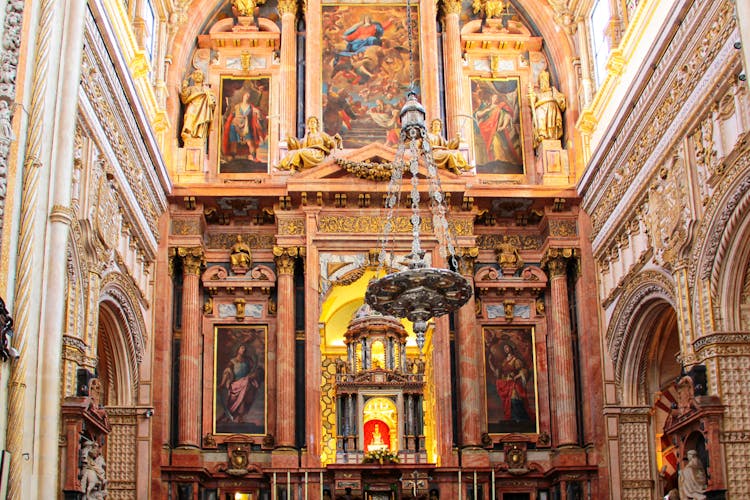
5The Bell Tower
Elevate your Cordoba Mosque visit (quite literally!) by scaling its Bell Tower. Another architectural reminder of Andalusia’s Moorish history that made way from Christian-era, the Renaissance-style Bell Tower encases a minaret. Today, the mud-brown Bell Tower is a grand 54 metres tall, is topped by a Saint Raphael sculpture, and is the tallest structure in Cordoba. Its decorated Venetian windows offer sweeping views of the historical city, making it a must-visit on your trip here.
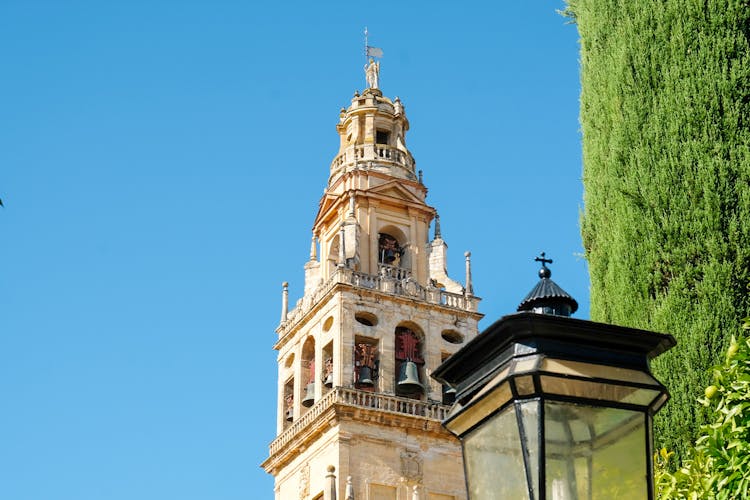
6The courtyard
Round up your trip to Cordoba Mosque with a leisurely tour of its Patio de los Naranjos (The Courtyard of the Orange Trees). When the site was a dedicated Mosque, the courtyard was made up of fountains and basins that served worshippers in their ablutions. The courtyard is lined with a series of chapels that were built in the years after the Reconquest. However, the place’s charm is retained by the crowds of orange, cypress and date trees that provide shade and a healthy dose of serenity.
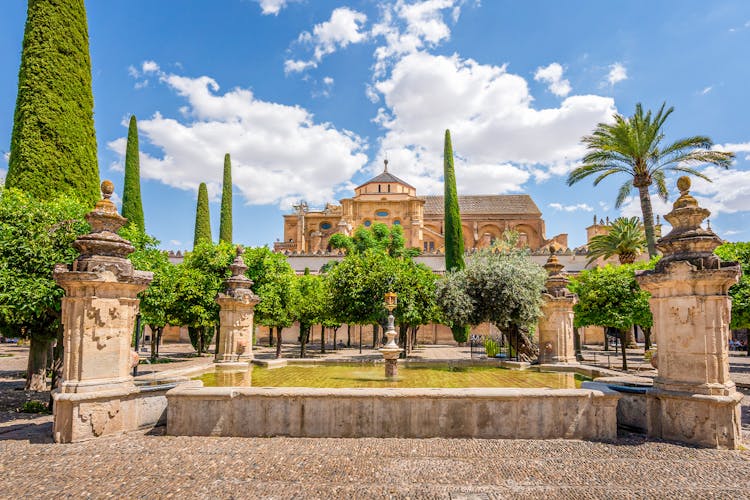
All you need to know before visiting Cordoba Mosque
Cordoba Mosque hours
The truth is that since this Cordoba Mosque is an in-use site of worship, the visiting hours are tricky and depend on whether there are special events, masses and festivals taking place. However, these are the general hours across the seasons:
March 1st to October 31st:
- Mon-Sat: 10am–7pm
- Sundays and Religious holidays: 8:30am–11:30am and 3pm–7pm
November 1st to February 28th/29th:
- Mon-Sat: 10am–6pm
- Sundays and Religious holidays: 8:30am–11:30am and 3pm–6pm
For an accurate schedule, we recommend you consult with the site’s time-table tool.
Bell Tower timings
There are slotted windows for the Bell Tower tour that begin at 9:30am and go until 5:30pm every day. Tickets to this experience have to be booked separately.
Cordoba Mosque entrance
The main entrance to Cordoba Mosque is at the Puerta de Deanes.
Cordoba Mosque directions
- 🚌 By bus: Bus numbers 3 or 12 lead to the Cordoba Mosque. The nearest stop is Puerta Del Puente which is a two-minute walk to the monument.
- 🚅 By train: The nearest train station is Córdoba. The station is 2km from the Mosque.
Cordoba Mosque map
Here is a detailed map of the historic Cordoba Mosque. It marks the entrance and the various facilities around the attraction.
Cordoba Mosque facts that will have you in awe
- It is reported that when Abd al-Rahman I captured Cordoba and decided to build a mosque at the site, it was occupied by a church and a mosque. Al-Rahman is said to have purchased the site for a thousand dinars and demolished the old structure to make way for the Cordoba Mosque.
- Abd al-Rahman I, who built the initial version of the Cordoba Mosque, is believed to be a descendant of Syria’s Umayyad dynasty. His lineage and history are reflected in the architecture of Cordoba Mosque whose features resemble those in the grand Umayyad Mosque in Damascus.
- In all its glory, the prayer hall of Cordoba Mosque is said to have featured over 1200 columns, about 850 of those survive today.
- In the 10th century, Cordoba Mosque occupied 8600 square metres and was believed to be the second-largest mosque in the Islamic world.
- In 1236, in the aftermath of the Spanish Reconquest, the site was dedicated to Santa Maria (the Virgin Mary). Today, the Mosque is officially known as the Cathedral of Our Lady of the Assumption and is the seat of the Cordoba Diocese.
Insider tips for visiting Cordoba Mosque
- This is a large complex even though it doesn’t come across in pictures. Wear comfortable shoes and carry a water bottle so that your visit is comfortable.
- The Bell Tower offers unmatched views of the city but the steps can be taxing. It is a 40-metre climb, equivalent to climbing 12 floors. Make sure you are in reasonable health to do so.
- For those with physical disabilities, the site offers discounts on tickets. There are also disability-friendly toilets, access to wheelchairs, and guides for the blind. Guide dogs are allowed to accompany you, on submission of the necessary documents.
- If you are attending mass at the Cathedral, they prohibit photography and videography of all kinds. Guards around enforce this rule strictly so consider yourself warned.
Ready to visit Cordoba?
Here are a few of the other must-visits in Cordoba.
1Roman Bridge of Córdoba
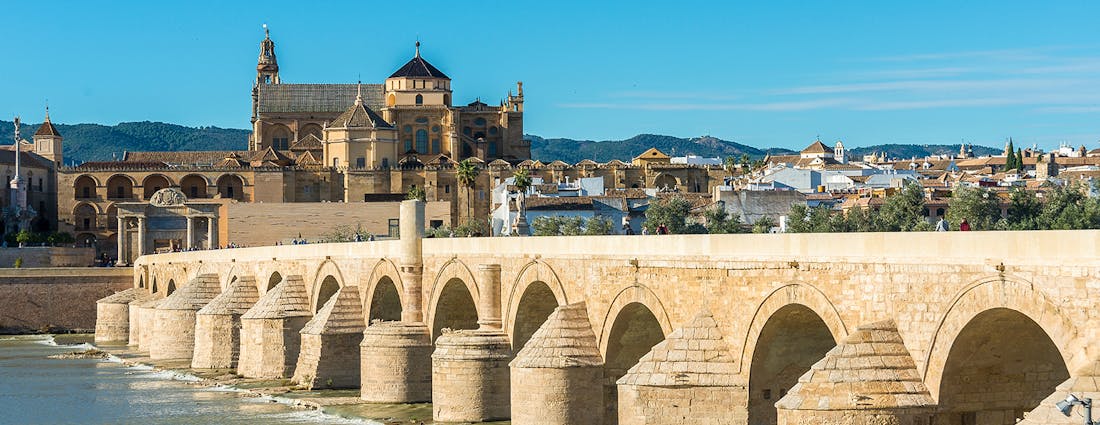
Located at the heart of Cordoba, the Roman Bridge traces its origin to the first century and was revised through the ages. Built on the Guadalquivir River, the bridge that stands today is made of stone features graceful arches and is said to be from the Medieval period. This bridge is popular for leisurely strolls and for breathtaking sunsets.
2Plaza de la Corredera
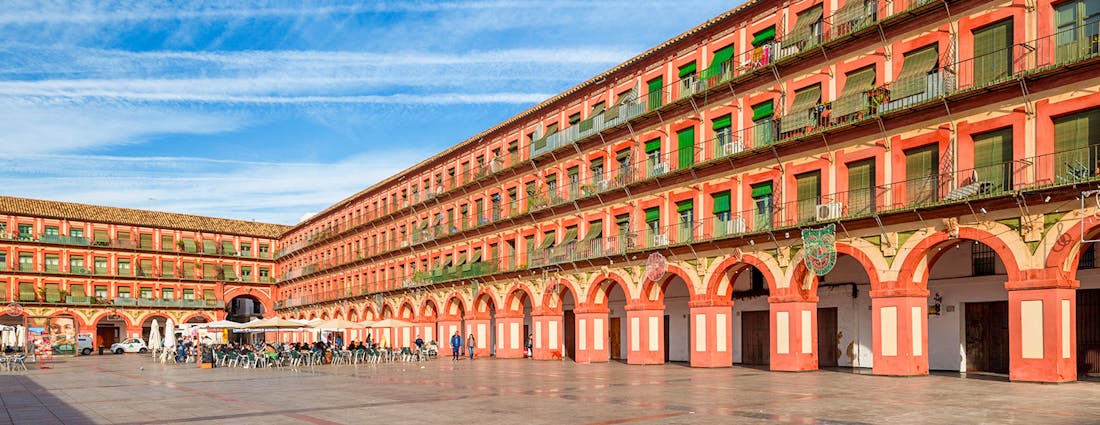
Constructed around the 17th century, Cordoba’s public square was once the site of bullfights and even witnessed the torture of many during the days of the Inquisition. However, today, Cordoba’s main square is dotted with balconied apartments, busy cafes and buzzing pubs.
3Cordoba Synagogue
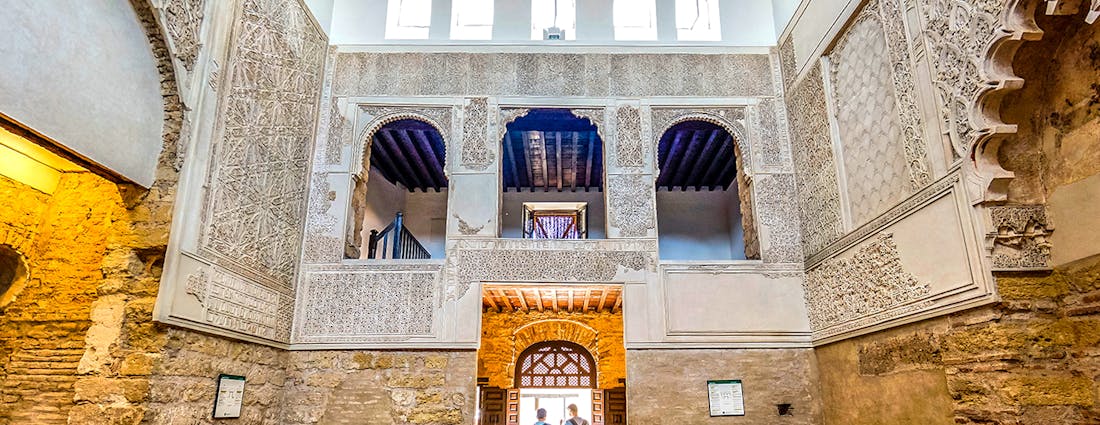
The star attraction of the Jewish Quarter, the Synagogue speaks of Andalusia’s rich and textured history. Built in the 1300s, this still-standing monument features courtyards and walls decorated with detailed plasterwork that showcase Mudejar artistry. When the Jews were expelled from Spain in the 1400s, the Synagogue was used as a hospital, a hermitage and a school. However, in the 19th century, Spain declared it a National Monument.
4Alcazar of Cordoba
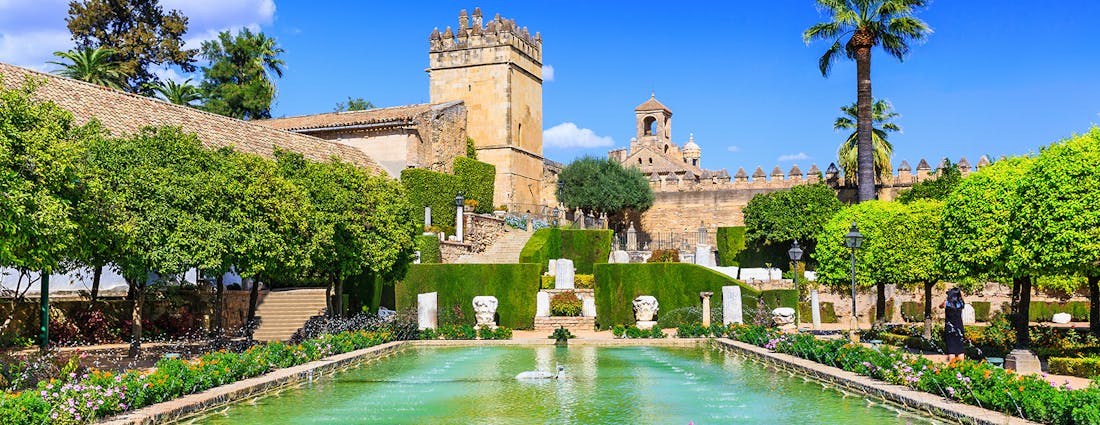
Known as the Castle of the Christian Monarchs, this Medieval-era fortress was the residence of the powerful Spanish monarchs after the Reconquest. Commissioned by Alfonso XI of Castile, the imposing fortress is marked by looming, corner towers and courtyards. Built on Roman and Moorish-era ruins, you can also discover Roman mosaics, royal baths and reception rooms. However, the highlight of your trip will be a walk through the sprawling, well-manicured gardens that occupy around 55, 000 square metres and are filled with orchards, lengthy pools and sculptures.
FAQs
What is the Great Mosque at Cordoba famous for?
What distinguishes the Great Mosque of Córdoba?
What is the Mosque of Cordoba now?
What is the Mosque of Cordoba made of?
Is Cordoba mosque open?
How many columns are in Cordoba Mosque?
What is the style of arch found at the Great Mosque at Cordoba?
How much does it cost to visit Mezquita (Mosque-Cathedral of Córdoba) 2021?
Should I book Mezquita (Mosque-Cathedral of Córdoba) tickets in advance?
When was the Great Mosque of Cordoba built?
Where can I purchase Cordoba Mosque Tickets?
Is the Cordoba Mosque in Spain?


